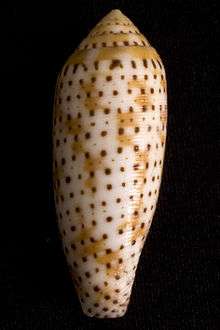Hermes (gastropod)
| Hermes | |
|---|---|
 | |
| Apertural view of shell of Conus nussatella Linnaeus, 1758 collected off Dar es Salaam, Tanzania | |
| Scientific classification | |
| Kingdom: | Animalia |
| Phylum: | Mollusca |
| Class: | Gastropoda |
| (unranked): | clade Caenogastropoda clade Hypsogastropoda clade Neogastropoda |
| Superfamily: | Conoidea |
| Family: | Conidae |
| Genus: | Conus |
| Subgenus: | Hermes Montfort, 1810 |
| Type species | |
| Conus nussatella Linnaeus, 1758 | |
| Synonyms | |
|
Theliconus Swainson, 1840 | |
Hermes is a subgenus of sea snails, marine gastropod mollusks in the family Conidae, the cone snails and their allies.[1]
In the new classification of the family Conidae by Puillandre N., Duda T.F., Meyer C., Olivera B.M. & Bouchet P. (2015), Hermes has become a subgenus of Conus: Conus (Hermes) Montfort, 1810 (type species: Conus nussatella Linnaeus, 1758) represented as Conus Thiele, 1929 [2]
Distinguishing characteristics
The Tucker & Tenorio 2009 taxonomy distinguishes Hermes from Conus in the following ways:[3]
- Genus Conus sensu stricto Linnaeus, 1758
- Shell characters (living and fossil species)
- The basic shell shape is conical to elongated conical, has a deep anal notch on the shoulder, a smooth periostracum and a small operculum. The shoulder of the shell is usually nodulose and the protoconch is usually multispiral. Markings often include the presence of tents except for black or white color variants, with the absence of spiral lines of minute tents and textile bars.
- Radular tooth (not known for fossil species)
- The radula has an elongated anterior section with serrations and a large exposed terminating cusp, a non-obvious waist, blade is either small or absent and has a short barb, and lacks a basal spur.
- Geographical distribution
- These species are found in the Indo-Pacific region.
- Feeding habits
- These species eat other gastropods including cones.[3]
- Shell characters (living and fossil species)
- Subgenus Hermes Montfort, 1810
- Shell characters (living and fossil species)
- The shell is elongated and subcylindrical in shape with a tubular body whorl. The protoconch is multispiral. The anal notch is shallow. The shoulders are rounded to subangular. The shell is ornamented with nodules which die out in the early spire whorls, two or more cords on the whorl tops, and well developed ridges on the body whorl. The periostracum is smooth, and the operculum is small.
- Radular tooth (not known for fossil species)
- The anterior section of the radular tooth is shorter than the length of the posterior section, and the blade is long and may cover the full length of the anterior section. A basal spur is present, the barb is short. The radular tooth has serrations, and a terminating cusp.
- Geographical distribution
- The species in this genus occur in the Indo-Pacific region, including Australia.
- Feeding habits
- The radular tooth suggests that these cone snails are vermivorous, meaning that the cones prey on polychaete worms, however Hermes nussatellus has been reported to feed on mollusks.[3][4][5]
- Shell characters (living and fossil species)
Species list
This list of species is based on the information in the World Register of Marine Species (WoRMS) list. Species within the genus Hermes include:[1]
- Hermes nussatella (Linnaeus, 1758): synonym of Conus (Hermes) nussatella Linnaeus, 1758 represented as Conus nussatella Linnaeus, 1758
The following species have become synonyms of other subgenera of Conus or Conasprella.
- Hermes artoptus (G.B. Sowerby I, 1833): synonym of Conus artoptus G.B. Sowerby I, 1833
- Hermes austroviola (Röckel & Korn, 1992): synonym of Conus austroviola Röckel & Korn, 1992
- Hermes kawanishii Shikama, 1970: synonym of Conus nussatella Linnaeus, 1758
- Hermes lizarum Raybaudi Massilia & da Motta, 1992: synonym of Conasprella lizarum (Raybaudi Massilia & da Motta, 1992)
- Hermes terryni (Tenorio & Poppe, 2004): synonym of Conus terryni Tenorio & Poppe, 2004
- Hermes triggi Cotton, 1945: synonym of Conasprella ximenes (Gray, 1839)
- Hermes viola (Cernohorsky, 1977): synonym of Conus viola Cernohorsky, 1977
- Hermes violaceus (Gmelin, 1791): synonym of Conus violaceus Gmelin, 1791
References
- 1 2 Hermes Montfort, 1810. Retrieved through: World Register of Marine Species on 07/21/11.
- ↑ Puillandre N., Duda T.F., Meyer C., Olivera B.M. & Bouchet P. (2015). One, four or 100 genera? A new classification of the cone snails. Journal of Molluscan Studies. 81: 1-23
- 1 2 3 Tucker J.K. & Tenorio M.J. (2009), Systematic Classification of Recent and Fossil Conoidean Gastropods, ConchBooks, Hankenheim, Germany, 295 pp.
- ↑ A.R. Calabrese (1971), Feeding observations of Conus nussatella (Linnaeus, 1757) Hawaiian Shell News 19(1):1.
- ↑ A.J. Peile (1939), Radula notes, VIII. Conus. Proceedings of the Malacological Society of London 23:348-355.
Further reading
- Kohn A. A. (1992). Chronological Taxonomy of Conus, 1758-1840". Smithsonian Institution Press, Washington and London.
- Monteiro A. (ed.) (2007). The Cone Collector 1: 1-28.
- Berschauer D. (2010). Technology and the Fall of the Mono-Generic Family The Cone Collector 15: pp. 51-54
- Puillandre N., Meyer C.P., Bouchet P., and Olivera B.M. (2011), Genetic divergence and geographical variation in the deep-water Conus orbignyi complex (Mollusca: Conoidea), Zoologica Scripta 40(4) 350-363.
External links
| External identifiers for Hermes (gastropod) | |
|---|---|
| NCBI | 6489 |
| WoRMS | 428970 |
- "Conidae". National Center for Biotechnology Information (NCBI).
- To World Register of Marine Species
- Gastropods.com: Conidae setting forth the genera recognized therein.
This article is issued from Wikipedia - version of the 1/14/2016. The text is available under the Creative Commons Attribution/Share Alike but additional terms may apply for the media files.